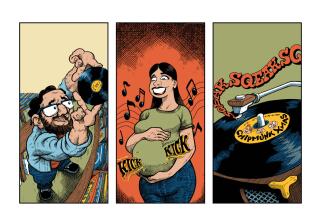THE CD REVOLUTION SPEEDS UP
- Share via
Imagine a record store that carries only a few records.
That may be what the future holds, because long-playing black vinyl albums--the heart of the music business for more than three decades--are fading fast.
An informal Times survey of manufacturers and retail chains indicates that music buyers are turning away in droves from the traditional LP in favor of cassettes and compact discs.
The vinyl album now accounts for less than 25% of every dollar spent on prerecorded music. Within five years, that figure is expected to drop to 10%.
Cassettes surpassed LPs three years ago and now command about 50% of the market, while compact discs soared from less than 5% of net dollar volume two years ago to a robust 20-plus percent today. These two formats are expected to wage a head-to-head battle for consumer favor into the 1990s.
While the LP has fallen off sharply, few observers expect it to go the way of the 8-track tape cartridge, the LP’s chief rival in the ‘70s but now virtually extinct.
“I don’t see the LP going away like the 8-track did,” says Sal Licata, president of RCA/A&M;/Arista Distributing. “It’s going downhill, there’s no two ways about it. But will it ever go out 100%? I don’t know. It might hang in there, but it’s going to be such a small percentage of our business, we’re going to have to look for ways to maintain pressing facilities.”
While all major labels conduct research on the popularity of various configurations, Licata said there are less scientific clues.
“Most of us have children,” he noted. “You try to bring an LP home to your son or daughter and they say, ‘Dad, where’s the cassette?’ That’s a good indication right there.”
Dennis Wingett, area manager for the 33-store Licorice Pizza chain, noted that his customers are already expressing concern about the future of the LP. “They’re asking that question every day: At what point are LPs going to stop being available?”
No one has the answer to that question, but Wingett suggests, “If LPs slip to the point that they’re less than 10% of the business, some tough dollars-and-cents decisions will have to be made. Can labels afford to keep producing them, and can we afford to let them sit on our shelves?”
“In five or six years from now the LP definitely will be extinct because of the quality of the CD,” said Kaz Ghavami, tape manager of Tower Records’ Sunset Strip store said. (Tower has 41 stores nationwide.)
“The price of an LP is going up and it will eventually cost the same as a CD. Look how much storage space an LP takes up compared to a CD.”
What if LP sales fall below 10%?
“We won’t abandon LPs because the simultaneous release of LPs and CDs is not possible yet. Everybody has a record player. A lot of people can’t wait that long for the CD.” Ghavami suggested that CDs will replace LPs only “when they become simultaneously available.”
The CD surge of the last two years is especially dramatic because several factors are working against the format. For one thing, CDs aren’t generally available until one to three months after the release of the LP and cassette. Also, demand has outstripped supply, leading to spotty availability and relatively high prices.
And there are still only 2 million CD players in the United States, in contrast to an estimated 80 million turntables and 140 million cassette players.
“Once the CD player population grows and there’s sufficient manufacturing capacity to feed those players, you’ll see a dramatic increase in the size of the business,” said Bob Altshuler, vice president of press and public affairs for CBS Records, the nation’s leading manufacturer.
Henry Droz, president of WEA (Warner/Elektra/Atlantic) Corp., the nation’s No. 2 manufacturer, anticipates an explosion in the CD player population.
Fewer than 1.5 million players were sold in this country in 1984 and 1985 combined, but Droz estimates that 2.5 million players will be sold in the United States this year alone. After that the numbers are expected to skyrocket. Droz projects that 4.6 million players will be sold next year, 8.2 million in 1988, 10.5 million in 1989 and 11.3 million in 1990. Grand total by the end of 1990: 38.5 million.
Several factors account for the rapid growth of the CD in the last two years. The price of CD players has plunged to as low as $150, and the price of CDs themselves has also dropped, from $20-$22 to $14-$15. There is now a broader array of titles available on CD, and the format has established itself as more than just the latest audio hype--the 1986 equivalent of quadraphonic and audiophile records.
Still, the CD’s rapid ascent has surprised many in the industry. Robbin Ahrold, RCA Records vice president of communications, noted, “I don’t think anybody would have predicted in their wildest imaginings that the CD would account for as much of the industry’s business as the LP as early as the end of this year.”
But that’s just what current projections indicate. In fact, Droz estimated that by the end of the year, CDs will account for 25% of WEA’s net dollar volume, compared to just 20% for LPs (cassettes will represent 50% of WEA’s business, singles 5%).
While the changeover may be inevitable, it won’t be painless.
“There are a lot of us who were vinyl junkies,” noted Alan Schwartz, director of creative marketing for Show Industries, which owns the 38-store Music Plus chain.
“The LP was easy to merchandise and full of all kinds of stimulation to a customer. It’s going to be a challenge to present the same kind of new release excitement if what customers are mostly going to be looking at are cassettes and CDs.”
Mitch Perliss, Music Plus director of purchasing, said that CDs have made their greatest inroads in classical music. CDs are also strong in pop-rock, though they’re only beginning to penetrate the jazz, country and black music markets.
Most believe that the current configuration upheaval will be good for the industry.
Gary Ross, senior vice president of marketing and merchandising for the 512-store Musicland chain, the nation’s largest retail chain of music specialty stores, observed, “It adds a new light and a new interest to the music business. Newness helps stimulate sales.”
More to Read
The biggest entertainment stories
Get our big stories about Hollywood, film, television, music, arts, culture and more right in your inbox as soon as they publish.
You may occasionally receive promotional content from the Los Angeles Times.










